


The ISC is now in its seventh year. This event is organised in an interesting way. The problems to be solved are sent out to controllers who organise a separate solving venue in each country (it’s possible to have more than one venue; there were two in the United Kingdom, for example). The controllers in each country open the envelopes and hand out the problems at the same time all over the world. You may wonder how this works, but as the participating countries are almost entirely European, the timing isn’t particularly inconvenient for most solvers, with only the poor Brasilians having to get up early. The solutions are marked by the local controllers and then they are sent back to the overall coordinator (this year Axel Steinbrink), who checks the marking.
A total of 288 solvers took part in this year’s event (211 in the main event and 77 in a special category for beginners), and the leading scores, out of a possible maximum of 60, were:
| 1 | John Nunn | UK | 55 points | 196 minutes |
| 2 | Miodrag Mladenovic | Serbia | 55 points | 221 minutes |
| 3 | Eddy Van Beers | Belgium | 54 points | |
| 4 | Ofer Comay | Israel | 53.5 points |
When points are equal, the tie-break is based on time used, which put John Nunn in first place. It was his first victory in the ISC, although he has been second on two previous occasions. Full results may be found here.

The winner in both tournaments: GM Dr John Nunn, England
Here are three problems from this event for you to solve. If you like to solve these under the same conditions as the competitors in the ISC, allow yourself 20 minutes for the mate in three, and 25 minutes for each of the other two problems.

White to play and mate in three
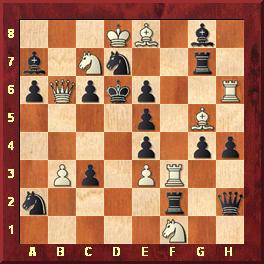
White to play and mate in five

Helpmate in six (two solutions)
In this helpmate, Black moves first and both sides cooperate to help White mate Black on White’s sixth move. Note that there are two solutions to this problem (starting with different Black first moves).
A few weeks after the ISC, many leading solvers gathered in Oakham, England for the annual British Problem Solving Championship, which has been organised by the British Chess Problem Society every year since 1980. This event, which is sponsored by futures and hedge fund manager Winton Capital, is also open to overseas competitors, although they are not eligible for the British Championship title.
The 2011 championship was a runaway success for John Nunn, who led from start to finish and solved every problem except one. The leading scores (from a possible maximum of 65) were:
| 1 | John Nunn | UK | 60 points |
| 2 | Eddy Van Beers | Belgium | 52.5 points |
| 3 | Michael McDowell | UK | 50.5 points |
| 4 | Jonathan Mestel | UK | 49.75 points |
| 5 | Colin McNab | UK | 49.75 points |
| 6 | Dolf Wissmann | Netherlands | 45 points |
One slightly unexpected result was the third place of Michael McDowell, who is a problem expert rather than a player, but who nevertheless finished ahead of over-the-board GMs Mestel and McNab. Full results are available here.
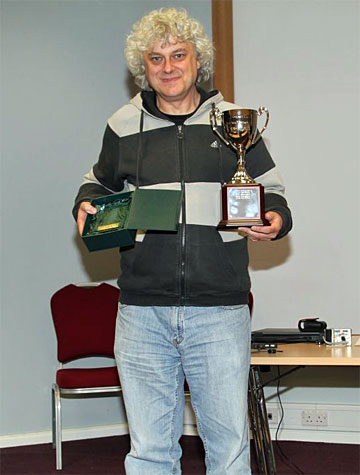
The current British, European and World Problem Solving Champion
Here are three problems from this event for you to solve. To replicate the tournament conditions, give yourself seven minutes for the mate in two, 20 minutes for the mate in three and 25 minutes for the selfmate. Of these problems, the mate in three proved most troublesome for the solvers at Oakham, with only three competitors scoring any points at all on it.

White to play and mate in two
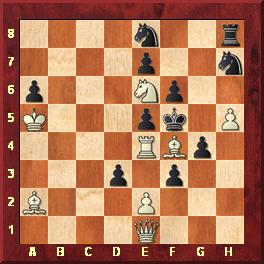
White to play and mate in three

White to play and selfmate in five
In this selfmate, White plays first and forces Black to mate White on Black’s fifth move at the latest. Black is trying to avoid mating White.
Solutions will be given next week.
As usual, when the name Nunn apprears in a ChessBase report, we cannot resist the temptation of including a few astronomical pictures. Our readers know the situation well: John, who has a fairly respectable telescope in his home in light-polluted England (see picture below), is a very active member of Global Rent-a-Scope (GRAS), an organisation that allows you to access remotely operated telescopes via the Internet. The site is operated by a small team of astronomers based in the USA, Australia, Canada and Europe, and can be used by amateur and semi-professional astronomers the world over. There you can access large instruments located in very dark and clear places and equipped with cameras that normal amateurs cannot afford. GRAS investment in the system exceeds two million dollars in telescopes, infrastructure and customized software.

John Nunn in his home in England, together with Dr Christian Sasse (left), who
set up and runs
GRAS, and Ken Thompson, the inventor of Unix and C, who is also a keen amateur
astronomer
Periodically John sends us stunning images he has captured in his GRAS sessions. The following is one of his best. It shows the galaxy M106, which is a spiral galaxy about 23.5 million light-years from Earth. Unusual radio emissions from this galaxy indicate that it has a black hole of about 36 million solar masses at its centre. The spiral arms of M106 are also rather odd, presenting a mystery which has only recently been solved.
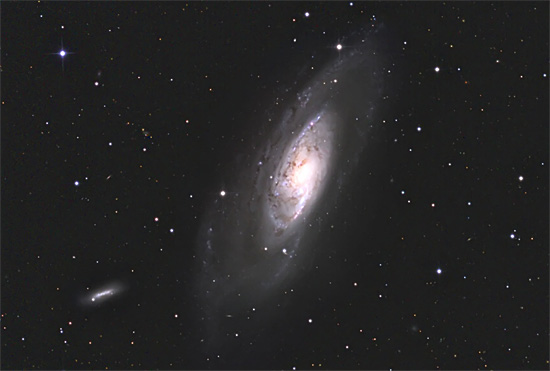
Click to enlarge to desktop size
Just below and to the left of M106 is NGC4248, a smaller galxy which is a similar distance away and is probably gravitationally linked to M106. Several fainter (and much more distant) galaxies can be seen in this image. For example, directly above NGC4248 you can see an edge-on spiral galaxy. The distance to galaxies such as these cannot be determined directly, but it can be inferred from the galaxy's redshift (in this case it appears to be about 850 million light-years away).
Talking about great distances: the German-Canadian physicist-engineer Christian Sasse, keen astronomer and all round good guy, recently embarked on a project to set up a new star machine that he felt certain would allow ‘amateurs’ to peer back in time, to galaxies far, far away. Actually…a certain quasar in Ursa Major, powered by a supermassive black hole three billion times the mass of our Sun.
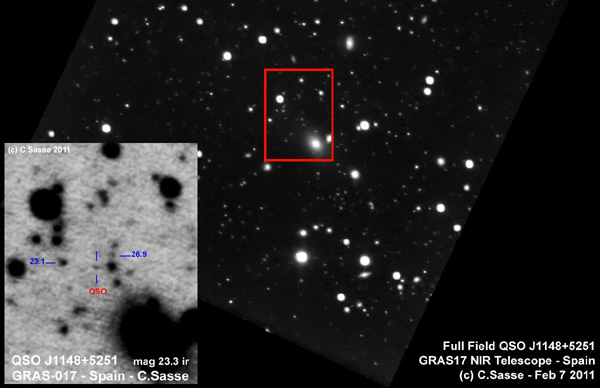
This monster roared into existence with brutal cosmic power only 870 million years after the universe began. It sends out infrared luminosity over 22 trillion times brighter than our own mediocre star, forming a huge bubble of carbon monoxide molecules 30 million light-years in diameter around its host galaxy.
Last month Christian pointed the newly commissioned G17 Deep Red Telescope based at the GRAS-Astrocamp facility in Spain, to an otherwise blank piece of sky. G17 proceeded to capture a few hundred thousand ancient photons on its CCD camera during 16 hours of exposures (199 x 300 secs). The first signs of the quasar appeared after about two hours of exposure. It should be noted, that this object is not amplified gravitationally by lensing. No short cuts here.

Christian Sasse showing GRAS to Vishy Anand, Ken Thompson and Luke McShane.
He is operating
a telescope in Australia on his notebook in his hotel room in London during
the 2010 Chess Classic
The Global Rent-a-Scope is well worth a visit, and you may even consider a trial membership.